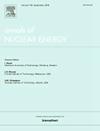Negative flux fixups using positivity-preserving limiters for SN-discontinuous finite element scheme of neutron transport equation on unstructured triangular meshes
IF 1.9
3区 工程技术
Q1 NUCLEAR SCIENCE & TECHNOLOGY
引用次数: 0
Abstract
One significant challenge of spatial discretization for the SN transport equation is the appearance of negative solutions, resulting in numerical algorithms to be unstable or slow iterative convergence in some problems. The discontinuous Galerkin finite element (DGFEM) spatial scheme on unstructured meshes has attracted much attention in recent years, but the issue of negative solutions is still a long-standing problem. This paper studies a negative flux fixup method using positivity-preserving limiters for solving the SN-DGFEM neutron transport equation. This method uses the hierarchical basis functions and triangular reference elements to obtain arbitrary high order DGFEM scheme. In the element where appears negativities, a scaling or a rotation positivity-preserving limiter is used to scale or rotate the polynomial distribution to ensure positive solutions. Five different types of problems are selected to verify the accuracy and convergence of the method. Numerical results demonstrate that the method can produce non-negative solutions and maintain the convergence order of the original scheme, as well as not introduce too much additional computational effort.
求助全文
约1分钟内获得全文
求助全文
来源期刊

Annals of Nuclear Energy
工程技术-核科学技术
CiteScore
4.30
自引率
21.10%
发文量
632
审稿时长
7.3 months
期刊介绍:
Annals of Nuclear Energy provides an international medium for the communication of original research, ideas and developments in all areas of the field of nuclear energy science and technology. Its scope embraces nuclear fuel reserves, fuel cycles and cost, materials, processing, system and component technology (fission only), design and optimization, direct conversion of nuclear energy sources, environmental control, reactor physics, heat transfer and fluid dynamics, structural analysis, fuel management, future developments, nuclear fuel and safety, nuclear aerosol, neutron physics, computer technology (both software and hardware), risk assessment, radioactive waste disposal and reactor thermal hydraulics. Papers submitted to Annals need to demonstrate a clear link to nuclear power generation/nuclear engineering. Papers which deal with pure nuclear physics, pure health physics, imaging, or attenuation and shielding properties of concretes and various geological materials are not within the scope of the journal. Also, papers that deal with policy or economics are not within the scope of the journal.
 求助内容:
求助内容: 应助结果提醒方式:
应助结果提醒方式:


